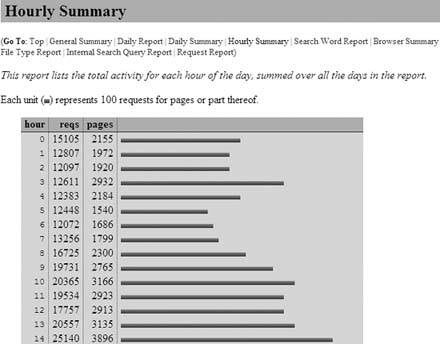Hack11.Use Analog to Process Logfiles
Hack 11. Use Analog to Process Logfiles
Analog is purportedly the most popular web server logfile analyzer in the world. If you're just getting your feet wet in web measurement, you might want to give it a quick try. Analog, written by Dr. Stephen Turner (one of the original web measurement hackers), is an easy-to-install and highly flexible web server log analyzeone that hundreds of thousands of people have likely tried at one time or another just to get a taste of web measurement. Since it's completely free, you might want to take the time to download and install the application and generate a few reports just for fun. 1.12.1. Analog: Where to Get It!Analog is made freely available by Dr. Turner at www.analog.cx. At the time this book was written, versions of the application were available for Windows; Macintosh OS 8, OS 9, and OS X; dozens of flavors of Unix, including BSD, Linux, HP-UX, and Solaris; and a motley collection of non-Unix platforms like BeOS, Novell Netware, and OpenVMS. You can also download the source code to compile on any known platform, if it suits your fancy. Visit http://www.analog.cx/download.html and select the version of Analog that works best for you. 1.12.2. How to Install AnalogOnce you've downloaded the application, on most platforms all you need to do is extract it using whichever application you normally use to extract archives. The archive will uninstall into an install directory, usually analog version], where [version] is the version of Analog you've downloaded. For example, if you downloaded Analog Version 6.0, you're going to end up with a directory called analog 6.0. To test your installation, simply navigate to the directory created and run Analog in the normal way for your operating system. For example, on Linux, you would just type ./analog, and on Windows, you would click on the executable analog.exe. In Windows, a DOS window will open and close, but a report file called Report.html should be created in the analog directoryone that when opened will present you with a sample report. If something went wrong, look for the errors.txt file, open that, and look for an explanation of what went wrong. 1.12.3. Telling Analog Where Your Logfiles AreAnalog doesn't have a Windows-style user interface. Instead, you configure it by putting commands in the configuration file analog.cfg. The first thing you need to tell it is where your web server logfiles can be found. The command for selecting a logfile is LOGFILE logfilename You can have several LOGFILE commands, and you can also include wildcards in the logfile name. For example, on Windows, you might use the command: LOGFILE C:\WINDOWS\system32\Logfiles\W3SVC1\*.log 1.12.4. Creating Basic Reports in AnalogOnce you've told the application where to look for your logfiles, all that's left is to generate basic reports based on those logs. The most basic command to get Analog to create a report is simply to click on analog.exe or run it from the command line. Still, Analog is very powerful, and you may choose to modify the reports to suit your specific needs in hundreds of different ways. Here are a handful of commands you can place in the analog.cfg to modify your reports:
For a more complete list of basic commands that can be issued to Analog, visit http://www.analog.cx/docs/basiccmd.html. 1.12.5. Running the HackOnce you've successfully downloaded and installed Analog, simply execute it on the command line. On a Windows system, for example, simply type analog.exe on the command line. The program will read the configuration file and place its output in a file called Report.html (or the file specified in the OUTFILE setting in analog.cfg). You can then open this report in a web browser to see the results. Figure 1-11 shows a typical example. Figure 1-11. Hourly summary report from Analog Consider combining Analog with Report Magic (www.reportmagic.org) to improve the visual appeal of the reports (Figure 1-12). Analog is a simple but powerful web measurement applicationone that will perhaps satisfy your entry-level needs if you're just getting into web data analysis. Dr. Stephen Turner and Eric T. Peterson |
EAN: 2147483647
Pages: 157